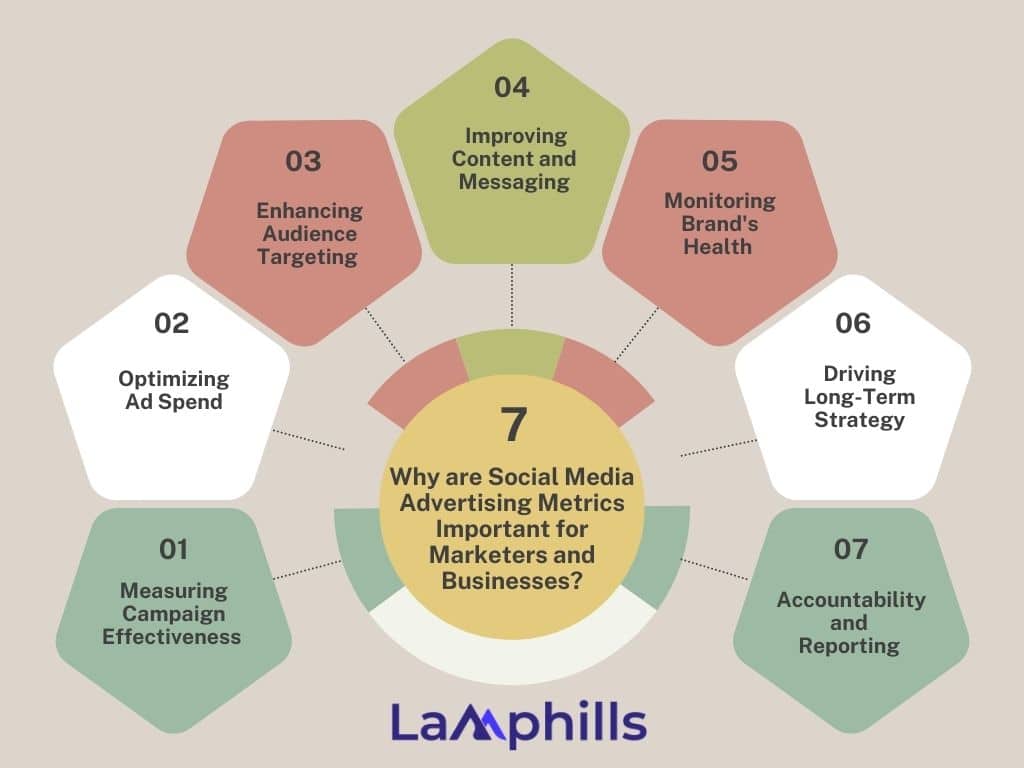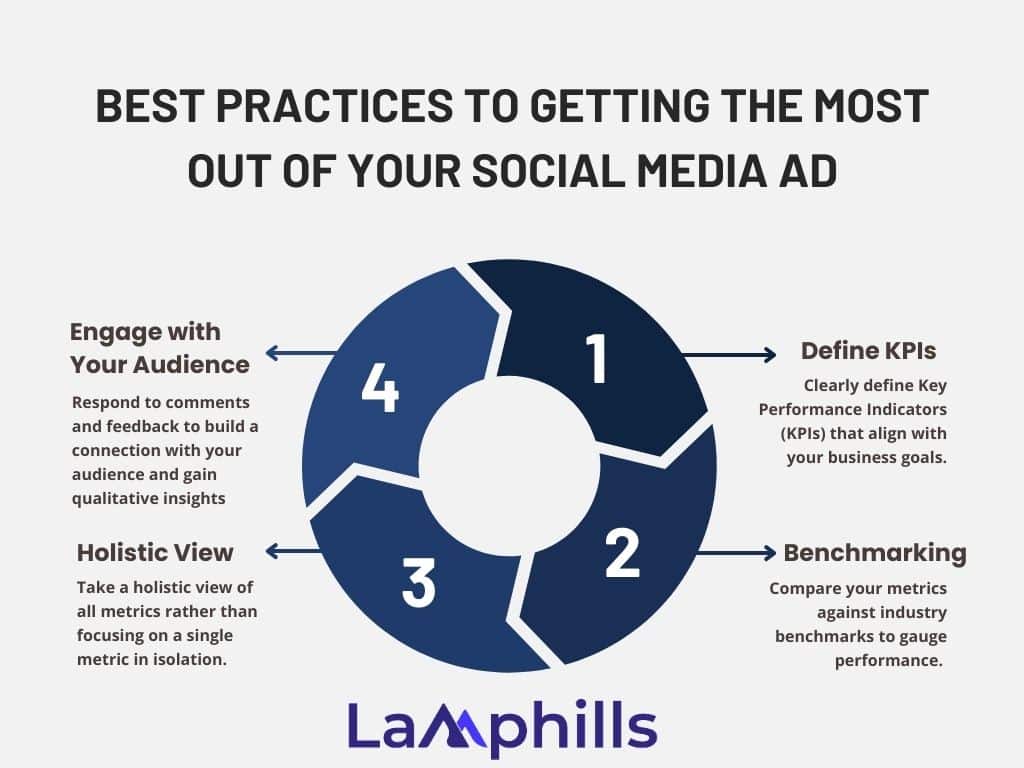In digital marketing, metrics are powerful tools and resources to gauge the success of every ad campaign. Understanding how to use these tools arms you with the tactics to tweak your ad campaign and get the desired result. They help you assess the effectiveness of the ads and make changes where necessary to get the most out of your campaign.
Social media advertising metrics are essential for marketers and businesses because they provide the insights needed to measure success, optimize strategies, enhance audience targeting, and drive long-term growth. I’ve been a digital marketer for half a decade, and based on my personal experience, the following are the top social media advertising metrics every marketer should track in their ad campaign.
Key Points
- Social media advertising is set to skyrocket to $219.8 billion by 2024, with mobile ads alone generating an astounding $255.8 billion by 2028.
- Social media advertising metrics are quantifiable measures used to evaluate the performance and effectiveness of advertising campaigns on social media platforms.
- These metrics are the backbone of a data-driven approach because they allow marketers to make informed decisions and maximize their advertising efforts.
- There are several free tools for tracking social media ads such as Facebook Ads Manage, Google Analytics, Twitter Ads Dashboard, LinkedIn Campaign Manager, Instagram Insights, YouTube Analytics, Pinterest Analytics, and so on.
- Some of the top metrics for measuring your social media ads include Impressions, Reach, Click-Through Rate (CTR)Cost Per Click (CPC), Conversion Rate, Cost Per Conversion (CPA), Return on Ad Spend (ROAS), Engagement Rate, Video Views and so on.
Understanding Social Media Advertising Metrics
According to Sprout Social, businesses allocate around 8.7% of their total revenue to their advertising budget. Interestingly, social media ads gobble up 28.8% of all digital advertising spend. And the future? Well, it’s bright and booming! Social media advertising is set to skyrocket to $219.8 billion by 2024, with mobile ads alone generating an astounding $255.8 billion by 2028.
Now, why are businesses pouring so much into social media advertising? It’s simple—they see the golden opportunities these platforms offer. They’re not just throwing money at ads; they’re investing with the expectation of significant returns. To ensure these investments pay off, they meticulously track the performance of their social media ads to ensure profitability in the long run. The good news is that social media platforms have various metrics to help businesses measure their ad performance and maximize their returns. These are our trusty social media metrics—or, as we call them, social media advertising metrics.
What are Social Media Advertising Metrics?
Social media advertising metrics are quantifiable measures used to evaluate the performance and effectiveness of advertising campaigns on social media platforms. Generally, these metrics help marketers understand how well their ads reach and engage their target audience and how effectively they drive desired actions. Also, analyzing these metrics enables businesses to optimize campaigns, improve return on investment (ROI), and make data-driven decisions.
Why are Social Media Advertising Metrics Important for Marketers and Businesses?

Having worked extensively as a digital marketer, I’d say social media advertising metrics are essential for any successful campaign. These metrics are the backbone of a data-driven approach, allowing marketers to make informed decisions and maximize their advertising efforts. The following are some of its benefits to marketers and businesses:
#1. Measuring Campaign Effectiveness
From my experience, tracking metrics like click-through rates (CTR), conversion, and engagement rates are indispensable. First, these metrics reveal the real impact of your campaigns, showing what works and what doesn’t. Secondly, let’s just say that without them, you’re flying blind. I mean unable to assess the true effectiveness of your ads, more like being the captain of a ship without a compass and good knowledge of the North.
#2. Optimizing Ad Spend
Effectiveness and efficiency are not for the production unit alone; every dollar counts in digital marketing. Metrics such as cost per click (CPC) and return on ad spend (ROAS) provide clarity on how efficiently your budget is being utilized. By understanding these metrics, I’ve reallocated funds to the most productive areas, ensuring maximum ROI.
#3. Enhancing Audience Targeting
One of the biggest advantages of social media advertising is the ability to target specific audience segments. Metrics offer insights into who is engaging with your ads and how. Analyzing this data can fine-tune your targeting strategies to reach the most relevant and high-converting audiences. I’ve seen these result in significant improvements in campaign performance.
#4. Improving Content and Messaging
Engagement metrics like likes, shares, comments, and video views are more than just numbers—they tell you what resonates with your audience. I adapt and refine content strategies to meet my audience’s preferences based on this analysis. The outcome is mostly higher engagement and stronger connections with potential customers.
#5. Monitoring Brand Health
Maintaining a positive brand image is paramount. Metrics such as sentiment analysis and social share of voice (SSoV) help monitor how your brand is digitally perceived. Moreover, positive sentiment and a high share of voice are indicators of a healthy brand presence, and staying on top of these metrics has been essential in ensuring long-term brand success.
#6. Driving Long-Term Strategy
Metrics are not just for immediate results—they inform long-term strategies. I do identify trends and anticipate market shifts by monitoring performance data. It’s always a saving grace because I can proactively adjust my marketing plans. In digital marketing, foresight is key to staying competitive and relevant in the evolving digital landscape.
#7. Accountability and Reporting
In my experience, metrics provide a transparent and quantifiable way to report the success of advertising efforts. This accountability is important for gaining stakeholder trust and securing ongoing support and investment. Moreover, clear, data-backed reports, demonstrate the tangible value of marketing initiatives.
Are There Free Tools to Measure Social Media Ad Performance?
Yes, there are several free tools available to help measure and analyze the performance of social media ads. The following are some of the best free tools:
- Facebook Ads Manager
- Google Analytics
- Twitter Ads Dashboard
- LinkedIn Campaign Manager
- Instagram Insights
- YouTube Analytics
- Pinterest Analytics
- Hootsuite (Free Plan)
- Buffer (Free Plan)
- Google Data Studio
Top Social Media Advertising Metrics Every Marketer Should Track
As a seasoned digital marketing expert, I’ve spent years fine-tuning campaigns and analyzing data to maximize returns. Tracking social media advertising metrics enables marketers to gain deep insights into their campaign performance, optimize their strategies, and drive better results. It maximizes the effectiveness of social media advertising but also ensures a robust return on investment. Although there are various metrics to track, the following are the most important ones to measure across Facebook, TikTok, Instagram, LinkedIn, and so on:
#1. Impressions
Tracking your ad impressions on social media platforms means you’re taking a count of the number of times your ad is displayed on users’ screens. It doesn’t matter if the ad is clicked or not; each appearance is counted as an impression. For instance, you must have come across several ads on Facebook or Instagram. Sometimes, you click on these if they catch your attention, at other times, you skip them. Impressions help you understand the potential reach of your ad. High impressions indicate good visibility, meaning your ad is being shown to a large audience. This metric is particularly useful for brand awareness campaigns where the goal is to get your message in front of as many eyes as possible.
#2. Reach
Reach refers to the number of unique users who have seen your ad. Unlike impressions, reach counts each user only once. It helps you understand the actual size of the audience seeing your ad. High reach suggests your ad is penetrating a broad audience, which is essential for growing brand awareness and extending market presence.
#3. Click-Through Rate (CTR)
CTR is the percentage of users who clicked on your ad after seeing it. It’s calculated as (clicks/impressions) x 100. CTR is a key indicator of how compelling your ad is. A high CTR means your ad is enticing users to take action, reflecting well on your ad copy, imagery, and overall appeal. It’s a direct measure of engagement and effectiveness.
#4. Cost Per Click (CPC)
CPC is the amount you pay each time a user clicks on your ad. It’s calculated by dividing the total cost of your campaign by the number of clicks. CPC helps you understand the cost-efficiency of your ad spend. A lower CPC means you’re getting more clicks for your money and you’ll need this to optimize your budget. Lastly, it allows you to manage and scale campaigns more effectively.
#5. Conversion Rate
The conversion rate is the percentage of users who completed a desired action (e.g., purchase, sign-up) after clicking on your ad. It’s calculated as (Conversions/Clicks) x 100. This metric is pivotal for evaluating the effectiveness of your ad in driving desired actions. Why? Because high conversion rates indicate that your ad is attracting clicks and also compelling users to follow through on your call to action.
#6. Cost Per Acquisition (CPA)
CPA measures the average cost to acquire a new customer or lead through your ad campaign. It’s calculated as total cost/total conversions. Generally, CPA is necessary for understanding the cost-effectiveness of your campaigns. It assesses whether the cost of acquiring a customer is justified by their lifetime value, aiding in budget allocation and strategy refinement.
#7. Return on Ad Spend (ROAS)
ROAS indicates the revenue generated for every dollar spent on advertising. It’s calculated as Revenue/Total Ad Spend. ROAS measures the profitability of your ad campaigns. In essence, a high ROAS signifies that your ads are generating substantial revenue compared to their cost, which is the ultimate goal of any advertising effort.
#8. Engagement Rate
Engagement rate is the percentage of users who interact with your ad (e.g., likes, shares, comments) relative to the number of impressions. It’s calculated as (Engagements/Impressions) x 100. This metric provides insights into how well your ad content resonates with your audience. High engagement rates indicate strong user interest and can enhance organic reach through social sharing.
#9. Video Views
You’ll only need to measure this if you use video ads. Again, video content sells faster than text, I think you should use more of it in your marketing campaign. Video views count the number of times your video ad is viewed. This metric helps you gauge the reach and impact of your video content. Video views are essential for assessing the effectiveness of video campaigns, especially for storytelling and brand messaging.
#10. View-Through Rate (VTR)
VTR is the percentage of users who watch your video ad to completion. It’s calculated as (completed views/impressions) x 100. VTR indicates the engagement level of your video content. A high VTR suggests that your video is captivating enough to hold viewers’ attention until the end, which is critical for delivering your full message.
#11. Bounce Rate
Bounce rate is the percentage of users who click on your ad but leave the landing page without taking further action. This is the last thing you want to experience as a digital marketer. A high bounce rate can indicate that your landing page is not relevant or engaging to users. Understanding this metric helps you refine your landing pages to better align with user expectations and ad promises.
#12. Ad Frequency
Ad frequency is the average number of times an ad is shown to the same user. Monitoring ad frequency helps avoid ad fatigue, where users become annoyed or indifferent to seeing the same ad repeatedly. Since optimal frequency ensures your ad stays fresh and engaging, you’ll have to measure this metric.
#13. Sentiment Analysis
Sentiment analysis measures the sentiment (positive, negative, or neutral) of user comments and interactions with your ad. This metric helps gauge audience perception and the emotional impact of your ad. Positive sentiment is indicative of a favorable reception, while negative sentiment highlights areas for improvement.
#14. Social Share of Voice (SSoV)
SSoV is the percentage of total social media mentions that your brand or ad campaign receives compared to competitors. SSoV helps understand your brand’s visibility and presence in the social media landscape. Since a high share of voice suggests strong brand awareness and influence relative to competitors, it’s one of the metrics digital marketers need to measure.
How Can I Measure the Effectiveness of My Social Media Ads?
Measuring the effectiveness of your social media ads is essential for optimizing your campaigns and ensuring you get the best return on investment (ROI). Drawing from my firsthand experience and best practices, the following is a step-by-step guide on how to do it:
- Set Clear Objectives
- Choose the Right Metrics
- Use Platform Analytics Tools
- Leverage Google Analytics
- Calculate ROI and ROAS
- Monitor Ad Frequency
- Conduct A/B Testing
- Analyze Sentiment
- Review and Adjust Regularly
- Use Third-Party Tools
Best Practices for Getting the Most Out of Your Social Media Ad

To get the most out of your social media ads as a marketer, it’s not enough to measure or track metrics, do the following too:
- Define KPIs: Clearly define Key Performance Indicators (KPIs) that align with your business goals.
- Benchmarking: As much as you can, compare your metrics against industry benchmarks to gauge performance.
- Holistic View: Take a holistic view of all metrics rather than focusing on a single metric in isolation.
- Engage with Your Audience: Always respond to comments as well as feedback to build a connection with your audience and gain qualitative insights.
Facebook Advertising Metrics
Facebook is one of the most widely used advertising platforms, and I love that it gives marketers various options in terms of measuring the success of an ad campaign. Tracking and analyzing Facebook advertising metrics can provide deep insights into your campaign performance. The following are some of the metrics that you can use to gauge the success of your ad on Facebook:
- Impressions
- Reach
- Click-Through Rate (CTR)
- Cost Per Click (CPC)
- Conversion Rate
- Cost Per Conversion (CPA)
- Return on Ad Spend (ROAS)
- Engagement Rate
- Video Views
- View-Through Rate (VTR)
- Ad Frequency
- Bounce Rate
- Page Likes
- Post Engagement
- Link Clicks
- Relevance Score
How Does Tracking Facebook Advertising Metrics Improve Ad Performance?
The following are some of the ways that tracking Facebook advertising metrics can improve your ad performance:
- It helps you optimize Ad spending: Monitoring CPC and CPA will help you adjust bids and budget allocation to maximize cost efficiency and ROI.
- Improve Targeting: Engagement metrics like CTR and post-engagement provide insights into which audience segments are most responsive, allowing you to refine your targeting criteria.
- Enhance Ad Creative: Metrics such as relevance score and CTR help identify effective ad creatives. This is then used to improve ad design and messaging.
- Increase Engagement: Tracking likes, shares, and comments helps you understand what content resonates with your audience, enabling you to create more engaging ads.
- Reduce Ad Fatigue: Monitoring ad frequency helps prevent overexposure of your ads, ensuring they remain fresh and engaging.
- Boost Conversion Rates: By analyzing conversion rate and bounce rate, you can optimize your landing pages and calls to action, improving the likelihood of user conversions.
- Measure Overall Impact: Metrics like reach and impressions provide a broad view of your campaign’s visibility, helping you assess its overall impact and adjust strategies accordingly.
Lamphills’ Comprehensive Social Media Campaign Performance Checklist
Download Lamphills’ Comprehensive Social Media Campaign Performance Checklist
What are Advertising Metrics?
Advertising metrics are powerful tools that quantify the success of an ad campaign, much like a compass guiding your ad strategy. These metrics track and measure the impact of your advertisements on audience behavior, revealing what resonates and what falls flat. Analyzing these insights, pinpoint what’s driving success, identify areas for improvement, and make informed decisions to optimize your campaign’s performance.
What is Metrics in Advertising?
Metrics are powerful tools that quantify the success of an ad campaign, much like a compass guiding your ad strategy. These metrics track and measure the impact of your advertisements on audience behavior, revealing what resonates and what falls flat. Analyzing these insights, pinpoint what’s driving success, identify areas for improvement, and make informed decisions to optimize your campaign’s performance.
What are the Two Metrics for Display Advertising?
The two key metrics for display advertising are click-through rate (CTR) and conversion rate. Other metrics are equally important, but these are the top two.
What are Metrics and KPIs?
Metrics are quantifiable measures used to track and assess the status of specific business processes. They provide data points that help organizations understand their performance, make informed decisions, and track progress. Metrics can apply to various aspects of a business, such as marketing, sales, customer service, and operations. On the other hand, Key Performance Indicators (KPIs) are specific, measurable values that demonstrate how effectively an organization is achieving key business objectives. KPIs are a subset of metrics however they’re critical to business success. They are used to gauge the performance of various business aspects, helping to determine if goals are being met.
Related Articles
- Step-by-Step Guide To How I Create a Successful Programmatic Advertising Strategy
- How to Write the Best Google Ads Copy in 6 Steps: Templates and Examples
- 9 Important Link-Building Metrics You Should Measure and Track for Your Campaigns
- Brand Measurement: Key Metrics and Methods for Evaluating Brand Performance






